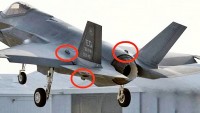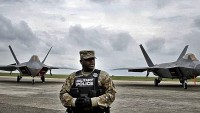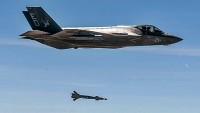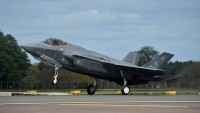US Air Force Allows Thin Pilots to Fly the F-35A Stealth Fighter
| Arthur Dominic Villasanta | | May 17, 2017 07:23 PM EDT |
(Photo : USAF) The Martin Baker Mk 16 US16E Ejection Seat.
Thin fighter pilots can now fly the Lockheed Martin F-35A Joint Strike Fighter after problems with the stealth fighter's Mk 16 US16E Ejection Seat were resolved, announced the U.S. Air Force.
The air force forbade fighter pilots weighing 62 kg (136 lbs) or less from flying the F-35A out of concern these pilots might either be severely injured or killed when ejecting from the aircraft.
Like Us on Facebook
Because of these dangers, no air force pilot below 62 kg have been authorized to fly F-35s since 2015. Tests conducted in this year showed unacceptable levels of risk of head or neck injury for thin pilots.
The flight restriction banning thin pilots from the F-35 was removed after the development and testing of fixes to the Mk 16 US16E Ejection Seat made by Martin-Baker and installed on F-35s.
Removal of the restriction on May 15 means pilots weighing between 46 kg (102 lbs) and 111 kg (245 lbs) can pilot the F-35A, the version of the stealth fighter flown by the U.S. Air Force.
Martin-Baker Aircraft Co. Ltd. is a British manufacturer of ejection seats and safety-related equipment for aviation. It claims its US16E Ejection Seat fully meets the F-35 Escape System requirements and is the only qualified ejection seat that meets the U.S. government defined Neck Injury Criteria (NIC) across the pilot accommodation range.
The fixes made by Martin Baker to the US16E Ejection Seat consist of new settings for thin or "lightweight pilots" and a head support panel, said Brig. Gen. Scott Pleus, Director, F-35 Integration Office, Headquarters U.S. Air Force.
Changes were to the F-35 Gen III Helmet Mounted Display System (HMDS) made by Rockwell Collins, Inc., to reduce the helmet's weight.
"Combined, these changes reduce the risk to lightweight pilots in both high- and low-speed ejections and make the F-35 ejection safest one of the safest in our entire inventory," said Gen. Pleus.
"We've done rigorous testing of all the new configurations, and it's clear that the combination of our lighter helmet, the delay in the opening speed of the parachute and the cradling of the pilot's helmet with a head support panel have significantly improved the safety of the seat."
TagsLockheed Martin F-35A Joint Strike Fighter, U.S. Air Force, Mk 16 US16E Ejection Seat, Martin-Baker, Brig. Gen. Scott Pleus
©2015 Chinatopix All rights reserved. Do not reproduce without permission
 US F-22, F-35 Stealth Fighters Evade Detection with Device that Makes Them Visible to Russian Radar
US F-22, F-35 Stealth Fighters Evade Detection with Device that Makes Them Visible to Russian Radar First US Air Force F-35s on European Mainland Forward Deployed to Bulgaria
First US Air Force F-35s on European Mainland Forward Deployed to Bulgaria F-35s can now Hit Moving Targets with Smart Bombs
F-35s can now Hit Moving Targets with Smart Bombs US Air Force F-35s Deployed to Europe for the First Time; Middle East to Follow
US Air Force F-35s Deployed to Europe for the First Time; Middle East to Follow
EDITOR'S PICKS
-

Did the Trump administration just announce plans for a trade war with ‘hostile’ China and Russia?
-

US Senate passes Taiwan travel bill slammed by China
-

As Yan Sihong’s family grieves, here are other Chinese students who went missing abroad. Some have never been found
-

Beijing blasts Western critics who ‘smear China’ with the term sharp power
-

China Envoy Seeks to Defuse Tensions With U.S. as a Trade War Brews
-

Singapore's Deputy PM Provides Bitcoin Vote of Confidence Amid China's Blanket Bans
-

China warns investors over risks in overseas virtual currency trading
-

Chinese government most trustworthy: survey
-

Kashima Antlers On Course For Back-To-Back Titles
MOST POPULAR
LATEST NEWS
Zhou Yongkang: China's Former Security Chief Sentenced to Life in Prison

China's former Chief of the Ministry of Public Security, Zhou Yongkang, has been given a life sentence after he was found guilty of abusing his office, bribery and deliberately ... Full Article
TRENDING STORY

China Pork Prices Expected to Stabilize As The Supplies Recover

Elephone P9000 Smartphone is now on Sale on Amazon India

There's a Big Chance Cliffhangers Won't Still Be Resolved When Grey's Anatomy Season 13 Returns

Supreme Court Ruled on Samsung vs Apple Dispute for Patent Infringement

Microsoft Surface Pro 5 Rumors and Release Date: What is the Latest?











